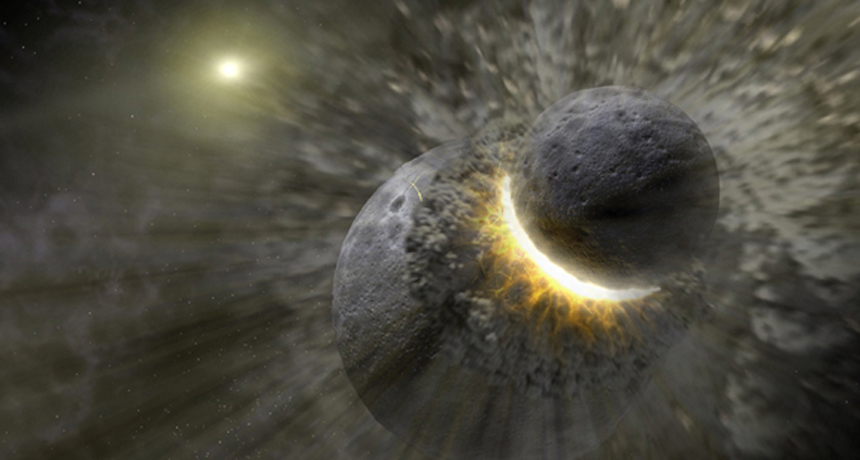Moon’s origins revealed in rocks’ chemistry
New chemical measurement supports giant impact hypothesis for lunar beginnings

BIG HIT A new analysis of moon and Earth rocks shows that the two bodies have slightly different chemical makeups, supporting the hypothesis that an object the size of Mars slammed into Earth, forming the moon.
NASA
The messy details of the moon’s birth just got a bit neater.
Earth and its little lunar sister aren’t actually twins, a new chemical analysis of Earth and moon rocks reveals.
The findings help iron out a big wrinkle in the giant impact hypothesis, the only idea about the moon’s origin that hasn’t been shot down yet, says Harvard University planetary scientist Sarah Stewart, who was not involved with the study.
“When everyone saw this work, we all breathed a huge sigh of relief,” she says. “In my mind, the giant impact hypothesis is still standing.”
According to this hypothesis, about 4.5 billion years ago a Mars-sized body called Theia bashed into the Earth, spitting out debris that mashed together to form the moon. Computer analyses of the collision suggested that the moon should be made mostly of Theia’s remains.
Because objects in the solar system have unique compositions, scientists assumed that the moon and Earth would have distinct chemical fingerprints, says study author Daniel Herwartz, a geochemist at the University of Göttingen in Germany. But until now, studies found the two to be made of exactly the same stuff.
“This was a major problem with the giant impact hypothesis,” Herwartz says. “People have been saying maybe the whole thing is wrong. Maybe the moon formed in some other way.”
Other ways are hard to find, Stewart says. “There was no second-choice model,” she says. “That’s why everyone hung on with dear life to the giant impact model.”
Stewart and others tweaked the theory a bit in 2012, varying the size of Theia and the Earth’s spin to find scenarios that left the moon’s composition matching Earth’s.
Around the same time, Herwartz and his colleagues revisited the chemical conundrum. They refined a technique to measure oxygen isotopes, versions of the element that vary slightly in mass. Scientists’ previous measurements had been within the technique’s error range.
Herwartz’s team cut the error by cleaning up the samples — lunar rocks brought back from the Apollo missions and Earth rocks — and then measuring only the rocks’ oxygen.
“That was the trick to getting better precision,” he says.
According to Herwartz’s measurements, the Earth and moon are nearly, but not actually identical in chemical makeup, he and colleagues report June 6 in Science. Their ratios of oxygen isotopes differ by about 12 parts per million.
“This is the first time people have really picked out a difference,” says geochemist Tim Elliott of the University of Bristol in England. “It’s an incredibly high precision piece of work.”
Even a slight difference eases the pressure on the giant impact hypothesis, Stewart says.
“We bent over backward with the 2012 impact models to try and make the Earth and the moon as close to each other as possible,” she says.“Now we don’t have to argue for something extremely special happening.”
The findings also hint about the birthplace of the moon’s mother, Herwartz says. Since the moon is so similar to Earth, both the planet and Theia may have formed in the same part of the solar system.







